
|
 |

|
|---|
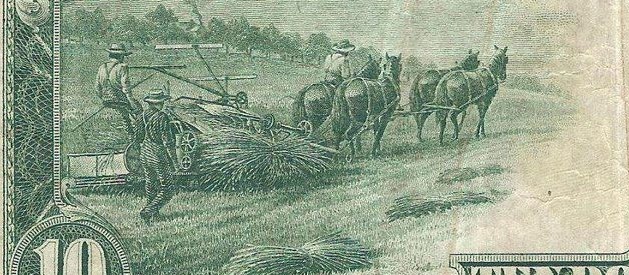
Part of a 1914 Federal Reserve Note Showing Hemp-Farming
THE ECONOMIC IMPACT TO OKLAHOMA'S TAX REVENUES
OF LEGALIZING MARIJUANA IN OKLAHOMA
7.0 - INDUSTRIAL HEMP GROWTH (Agriculture Tax Revenues)
Now that we’ve covered the minor stuff, we’ve finally come to what can only be considered; --- The ELEPHANT IN THE ROOM --- INDUSTRIAL HEMP growth within the state of Oklahoma. To which. . . if all the rosy projections are true, . . and if all the planets align themselves properly, . . and if purple rain begins to fall, . . . and if, . . etc., can contribute as much as $200,000,000 dollars per year, in direct additional tax revenues to our states coffers. Not to mention billions to our state economy, which in turn (more money means more spending) leads to increase sales tax revenues, etc.
How’s that possible? Let’s do a little “wishful thinking math.” Although agriculture is an over $7 Billion dollar a year industry here in Oklahoma, the bulk of that is in ranching. With crop growth, including everything from wheat to alfalfa accounting for only about a third or $2 Billion of that figure. And as half of all farm income is taken up by expenses (meaning it’s tax deductible), crop farmers therefore are paying taxes on only half or $1-Billion dollars of that.
Now, again using wishful thinking, if ALL crop farmers switched to Industrial Hemp AND if the reports of farmers who have switched to hemp and are now racking in three-times as much for their crop ARE TRUE. Then some quick math shows that these farmers will now be paying EXTRA taxes (in excess of what they were paying before) on some $4 Billion dollars in excess earnings. Which, assuming the farmers actually paid 5% of those earnings as taxes, equals some $200 Million dollars in additional tax revenues to the state.
REALITY CHECK:
HOWEVER, what if we did NOT use wishful thinking? What if the planets did NOT align themselves just right; what then? Then a couple of interesting question must be asked.
- Is it realistic to expect that ALL of Oklahoma’s crop farmers are going to switch over to Industrial Hemp growth?
ANSWER: Fat chance of that happening (at least not overnight), and in addition some of the crops being grown (alfalfa, etc) are being internally used for ranching purposes, so no way they’re going to switch. HOWEVER we can expect numerous acres presently classified as marginal, as well as converted ranchlands to (upon re-legalization) be placed into Hemp product. - Is that three-times (3-X) profits on Hemp crops a realistic figure or just a fantasy?
ANSWER: The answer is that in some cases, it is very real and in fact, a bit on the low side.
7.1 - INDUSTRIAL HEMP IN OKLAHOMA:
Some Background Notes:
QUESTION: JUST HOW MUCH REVENUE, actual new tax revenues will the State Oklahoma make off of the newly created agricultural Hemp Industry?
ANSWER: Realistically speaking (assuming no tax increases), between $50 and $200-Million dollars in new tax revenues; --probably toward the higher end.
Which is quite a large spread and unfortunately, one that the reader will have to learn to live with. For as will soon be seen, there are multiple problems with trying to pin down an actual dollar figure. Not the least of which is that fact that Industrial Hemp cultivation is ILLEGAL in present day Oklahoma. Thus there are no free market statistics that we can reference.
Next, all reports (so-far) written about the subject, at least ALL THOSE OBSERVED by this report, seem to be very slanted one-way or the other. There are those who say that by re-legalizing, that we will be creating (allowing to flourish actually) a totally new, multi-Billion dollar a year industry. One that in turn will provide thousands of new (high paying) industrial as well as agricultural jobs, which in turn will generate hundreds of millions of dollars in new tax monies to the state coffers. But just how realistic are these figures? To quote Valerie Vantreese (1997) [19]
PROFITABILITY OF HEMP VERSUS OTHER CROPS: -- There have been some attempts to calculate the profitability of hemp versus other crops. It is not surprising that those entities that strongly favor legalization of industrial hemp production have, in general, the most favorable profit margins and multipliers effects.
To which the same can be said of the opposition’s point of view. Some of the studies they’ve come out with are (well lets face it) nothing more than blatant bigoted trash. Obviously put together by those with an agenda which (again, let’s face it) is not very favorable to Industrial Hemp growth; -- irregardless of the facts.
But in either case, the question still remains - Just how much tax revenue can realistically be expected to come in from Industrial Hemp growers? --- THE ANSWER, as the reader will soon see, strangely enough, does not depend upon the figures themselves, but instead upon how one manipulates them. Thus in order to answer the question fairly, it is important to first understand a little about the math and just what the figures mean.
And in order to do that we first have to know a little about the subject. In other words, the technicals involved.
7.2 - INDUSTRIAL HEMP IN OKLAHOMA:
A SHORT COURSE ON INDUSTRIAL HEMP GROWTH:
What we’ve come today to know as Industrial Hemp, while a distant cousin to the Marihuana plant, is not really one and the same plant. And while some botanist may differ, as they say in New York;
“If it looks like a Duck,
if it walks like a Duck,
if it quakes like a Duck.
. . .then it’s a Duck.
And as this one doesn’t Look Anything Like a Duck, therefore, IT’S NOT a Duck.
The Marihuana plant (Cannabis Indica) grows to a height of about 4-feet, and its resin (found in the flowering tops of the plant) contains the material used to make medicines as well as for the recreational stuff. On the other hand, Industrial Hemp (Cannabis Sativa) has been known to grow more than thirty-feet in height (17-feet being more the average) and while also having flowering tops, their content is simply too weak for any recreational or medical use.
However, the way our narcotics laws were written, both sub-groups are treated as being one and the same. Thus ONLY AFTER Marijuana becomes legal in Oklahoma will it be possible to once again cultivate Industrial Hemp crops in this state.
[EDITORIAL NOTE: While it is tempting to say we will legalize one but not the other, the way things work out in real life, and given Oklahoma’s OBN (Bureau of Narcotic) very vibrant history of harassment, (they’ll for sure claim that one is the other), both are simply going to have to be legalized at the same time.
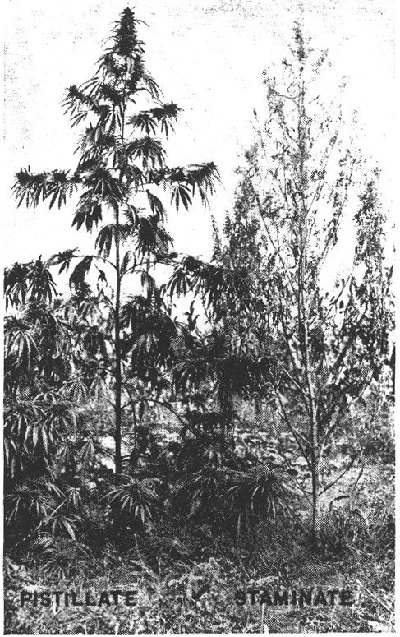
[Two fully-grown hemp plants] [female plant left, male plant right] |
The picture (left) [20] shows two fully-grown hemp plants (female on the left, male on the right). Note the long thin stalk, which is important as it contains very long, very hard fibers. Fibers which in turn can be used to manufacture everything from clothes to rope to canvases to . . . a whole lot of stuff. And despite what the Levi Straus Co. says, it does appear that the first pair of blue jeans was indeed made out of Hemp cloth. [SEE ADDENDUM-B] And it’s not just the long stalks that are important, the plants Seeds themselves (assuming they are grown for such) can be used for medical, nutritional and Industrial purposes. For example, the first automobiles were originally designed to run, NOT ON PETROLEUM fuel but on gasoline made out of Hemp Seed Oil. [NOTE The oil content of Hemp Seed usually ranges between 29 and 34 %, mix that in with a few other organic materials and you have a great bio-fuel] But that is nether here nor there, the only point being made here is that the Industrial Hemp plant has a lot of uses. Meaning, it’s a great cash crop, which if legal, could bring Oklahoman farmers, lots and lots of extra revenues. |
|---|
These two images (below) give us a better look at what’s inside of the Hemp stalk.
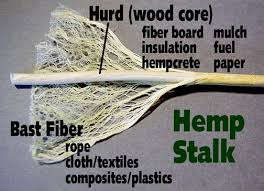
|
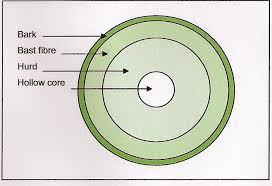
|
|---|
Ignoring the donut hole in the middle, there are three parts to the Hemp stalk.
- - The outer bark
- - The outer part of the stalk which is called the Bast fiber, is made up of very long, very hard, natural fibers. Fibers which are far superior to cotton and can be used to make rope, cloth, etc., in fact anything you can do with cotton fibers, you can do with Hemp fibers. [See Addendum-B] Which contains bits and pieces from old Sear’s mail-order catalogs, offering various Hemp products for sale. Everything from rugs to furniture and bedding materials.
- - The inner core called the Hurd, which can be used to make everything from particleboard to paper products. In fact, Europeans are using these Hurd cores to manufacture houses out of them.
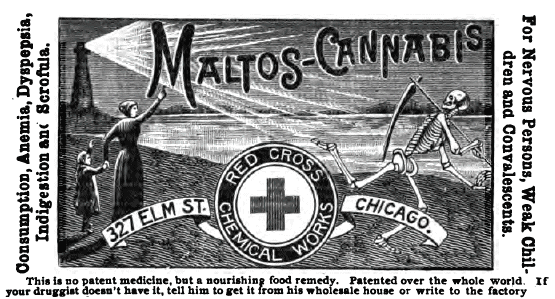
[Advertisement - Era 1890’s]
And so many other things that it would be all but impossible to attempt to mention them all here. Let’s just say that 95% of the plant (by weight) has its uses and that farmers are indeed make a lot of money out of it.
Something, which brings us back to the question, just how much in tax revenues will this New Industry generate? Which as stated previously, is a hard figure to pin down because of numerous factors. Hemp being a commodity means that any answer will depend upon a variety of factors, such as the number of other Hemp farmers, weather conditions, etc. Thus it behooves us to examine some of these factors. So let’s continue to examine the major technicalities involved. As per the following sections:
- Sec. 7.3 - The number of planing seasons per acre per year
- Sec. 7.4 - The yield per acre per year
- Sec. 7.5 - Marginal farmlands added to production
- Sec. 7.6 - The foreign (low cost) importer factor
- Sec. 7.7 - Weather and soil factors
7.3 - INDUSTRIAL HEMP IN OKLAHOMA:
NUMBER OF YEARLY PLANTING SEASONS PER ACRE:
QUESTION: How many planting (crop growths) can an Oklahoma farmer realistically expect to have each year?
The answer to this question varies quite a bit depending upon weather conditions and whether the crop is being grown for seed or as a fiber stalk crop. Assuming the acreage is already set up for crop growth, the answer can vary between two, three and possible even four Hemp crops for year. Why such a spread? According to a study done by the DEA (then known as the Federal Bureau of Narcotics):
REPORT OF THE MARIHUANA INVESTIGATION: [21]
A thinly spread seed crop, follows the following chronology of growth:
- May 12, 1937 Seed Sown
- by May 17, 1937 Plant appeared above ground
- by June 15, 1937 Height was 1 1/2 feet
- by July 2, 1937 Height was 6 feet
- by July 9, 1937 Height was 7 feet === KEY MILESTONE #1
- by July 16, 1937 Height was 10 feet
- by July 23, 1937 Height was 10 feet
- by August 15, 1937 Height was from 13 to 15 feet and all male plants could be distinguished === KEY MILESTONE #2
- by September 1, 1937 The fruit (meaning the seeds) had appeared and males began to wither === KEY MILESTONE #3
- by October 1, 1937 The male plants had been reduced to bare stalks, retaining, however, portions of their flowering tops.
- On October 25, 1937, when the leaves were mostly gone and the stalks were more readily visible, it was found that the plot contained approximately 3,100 plants of which approximately 1900 were females, and approximately 1,200 were males.
The FIRST KEY MILESTONE (highlighted in red) of a stalk around 7 feet long was reached in less than two months. This point is important because during the Second World War, five to eight-feet was the ultimate (given the equipment their Hemp Mills had at the time) processing length. Thus, it is technically possible (but highly improbable) to have SIX short seasons or plantings.
The SECOND MILESTONE, when the stalk reaches a height of between 13 to 15 feet, was reached in a little more then just 3 months. Meaning a total of four such crop growths could technically be had per year. However, the reader should note that a two-month growth season provides the farmer with a stalk around 7-feet high, yet given an extra month almost doubles its height. Meaning twice the crop value. --- Which brings up an interesting question; -- Why would a farmer cut down his crop in only two months when she could wait yet another month and get twice as much for her crop?
The answer is simply, while that might be a ludicrous thing to do in the summer, sometimes the winter months do not always agree with ones plans. That plus the time consumed in the actually seed planting, harvesting, etc., will probably reduce most farmers to no more than three-main harvests and maybe one short one per year.
However, IF the crop is being grown for seed, then there is a THIRD MILESTONE which occurs roughly four-months into the planting. The point where the seeds actually become ready. --- A factor that translates into no more than 2-Seed crops and 1-stalk crop per year. HOWEVER , a hemp crop can withstand light chills and given Oklahoma’s favorable weather patterns as the table below shows, it is very likely that any given crop season here could easily straddle the calendar.
| State | Snow Averages * |
| Oklahoma | 7.8” per year |
| Illinois | 24.6” per year |
| Indiana | 25.9” per year |
| Iowa | 34.9” per year |
| Wisconsin | 50.0” per year |
| Minnesota | 54.0” per year |
And NO, the comparison states were NOT chosen at random. But instead because they were the Key Industrial Hemp Growing states during the Second World War (also known today as the “Hemp For Victory” period). But in any case, the table shows one thing – a lot more Hemp plantings are possible here in Oklahoma than in many other places.
So returning to the question; --- Exactly how many planting per year?
Before attempting an answer, (aside from weather, which even here in Oklahoma can still take us for a spin), there is yet one more major variable that needs to be addresses. Is the planting being made for stalk growth or seed harvesting? According to the Farmers Bullet (Issue No.1935):
- If being grown for Seed production, plantings should be made thinly spaced. This allows each plant to receive maximum sunlight, which also allows the stalk to grow to a height of about 12 to 16 feet.
- However, if being grown mostly for stalk, then a thicker seed planting method is to be used. Due to limited sun-light received by each plant the stalks will only grow to a height of around 5 to 8-feet, but because there are more of them, the farmer will obtain more product.
* This data came with a strong warning: -- “Across many of the states, the amount of snow that normally falls varies widely. So meaningful statewide averages for snowfall aren't available. Instead the tables here list a place for each state that represents the state's annual snowfall.” [see footnote #22]
7.4 - INDUSTRIAL HEMP IN OKLAHOMA:
YIELDS PER ACRE:
QUESTION: How much of a yield can an Oklahoma farmer realistically expect to obtain from an acre of land?
In answer to this question we must first go over some definitions:
- Hemp STRANDS usually refer to the long parallel strands of fiber that are obtained from the long Hemp stalks. Note these are the ones that are best for ropes, etc.
- Hemp TOW refers to the shorter strands that come from broken pieces of Hemp stalks. It’s the same stuff as Hemp strands, but (because they come from broken Hemp stalks) they are thus a lot shorter.
- The term Hemp FIBER can be used to mean either Hemp Tow or Strands. In today’s cloth industry, the two terms are used interchangeably. Please keep in mind that only between 20% to 30% of the Hemp stalk is made up of Hemp Fibers, the rest consisting (primarily) of the Hurd.
- The Bast Fibers make reference (yet once again) to the Hemp fibers and/or Tow fibers.
- Hemp Straw is the same as saying Hemp Stalks, but the term is usually used to mean, the pure stalk after it has been cut and cleaned of leafs, etc.
- The Hurd or the stalks inner core can best be thought of as a hard wooden stick, which can be used to make everything from particleboard to paper products. The Hurd takes up about 50% to 70% of the Hemp stalks total volume.
- Shivs is another word for Hurd, that is used in Europe a lot.
- A TON is a unit of weight and is equivalent to 2,000 pounds.
- Remember; the Hemp fibers constitute less than 30% of the total weight of the Hemp stalk, therefore a pound of Hemp stalks DOES NOT equate to a pound of Hemp fiber.
- Likewise, a pound of Hemp Seed does NOT equate to a pound of Hemp Seed Oil, etc.
“The total area of land devoted to the cultivation of hemp in 1889 was 25,054 acres, and the production of fiber 11,511 tons“Which if one does the math:
[ (25,054 acres / 11,511 Tons of Fiber) = 0.46 tons per acre ]
Which (as noted earlier) as the fiber part of the Hemp stalk constitutes only 20 to 30 percent of the stalks total weight (here we assume 25% so as to keep the math easy), that would mean that to total stalk harvest weight was equivalent to:
[(0.46 tons / 0.25%) = 1.84 Tons of Hemp stalk per acre]
Or as one ton is equivalent to 2,000 pounds, that would mean that we are talking about:
[(1.84 tons x 2,000 pounds) = 3,680 pounds of Hemp stalks]
Which also implies (assuming Hemp hurds make up 65% of the stalks weight) that there:
[(3,680 x 65%) = 2.392 pounds of Hemp Hurds ]
Which for the year 1889 (given their technology) sounds about right. According to the Washington Post (referring to WW-2, Hemp For Victory Farmers):
WashingtonPost1944-10-22pM2- “Farmers Find Hemp Raising Pays in Illinois” “Illinois growers realized $42.90 a ton on hemp and had a yield of 2.6 tons an acre in 1943, according to R.H. Wilcox, associated professor of agricultural economics in the University of Illinois College of Agriculture. Cost of production and delivery was $21.19 a ton, Professor Wilcox said. “And here note that - (2.6 tons x 2,000 pounds = 5,200 pounds) of Hemp straw per acre per year and this was done in the middle of “Snow Bound Illinois.” One can only imagine what yearly yields we would have here in Oklahoma, given our much more favorable weather conditions to which even the Europeans are envious of.
As an aside, it is interesting to note that much of the world today is very tight-lipped about exact crop yields. We can only assume that this has something to do with business/marketing reasons. However, it is interesting to note that (through oral word of mouth) modern-day farmers are reporting yields well above 3-tons and some claim that given our modern technology, that the figure of 5-tons per acre is reachable.
7.5 - INDUSTRIAL HEMP IN OKLAHOMA:
DEALING WITH MARGINAL CROPLANDS?
So far we have been dealing solely with pre-existing farm lands; That is to say flat/graded acreage, presently under the cultivation of experience farmers. However, at present agricultural crop growth only accounts for about a third of Oklahoma’s agricultural lands (the rest being devoted to ranching). Thus the question; “What if marginal lands, normally not associated with crop production were devoted to Hemp farming?” Lands running up and down hillsides or grasslands with such poor soil conditions that other then weeds (no pun intended) or grasses, at present nothing can be grown there. Lands now devoted solely to raising livestock, etc.
And it’s not such a far-fetched idea to believe that such lands can be brought into productive crop use. Recalling the words of George Washington (yes, that George Washington): [24]
“Hemp, Grow it Everywhere”Which is a statement that is offend taken out of context. What he actually stated (in a letter to his farm manager), was something more like; “. . on the upper 10-40 acreage grow corn . . and on the lower acreage grow wheat. . . and etc.“ And then only towards the end those he write , . . and everywhere else on my farmlands, “Hemp, grow it everywhere.” Meaning grow hemp where nothing else is going to grow or could be grown anyway.
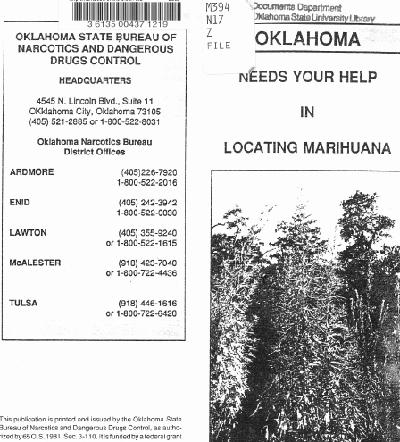
|
And here in Oklahoma, does it ever grow. According to our own O.B.N.: “Twenty years ago, they found and eradicated about 200,000 plants during their summer sweeps, but that number has been reduced to between 20,000 and 30,000 in recent years, he (spokesperson Mark Woodward) said” [25] Translation, the stuff is growing wild just about everywhere, meaning that it will grow just fine on (what we now consider to be) marginal soil. --- Thus growing Hemp on what is now considered marginal lands is actually a pretty good sound idea. |
|---|
BUT just how many new acres of land will be added? And what will their crop yields be? For obvious reasons no one at the present time knows. But there are several factors that we can look at.

|
(From the pamphlet) Soil Type and Soil management Factors in Hemp Production - July 1947 Sub-caption reads: Fig.6. The bundles from left to right shows the comparative growth of hemp following sorghum, corn and soybeans. Thus while Hemp (in terms of the soil), is of-and-by-itself a pretty ecological friendly plant. As can be seen, it still requires and takes some nutrients out of the soil. And while established farmers could easily add Fertilizer to the soil, a rancher type would not be able to do so, so easily. -- Meaning that in all likelihood, hemp planting might be limited to one or two growth seasons per year in order to revitalized the soil. |
|---|
In addition it should be kept in mind, that in some cases we are talking about the sides of hilltops, etc., thus thickly grown hemp plantings are not very practical. On such soils, it will probably be more economical to grow hemp for seed value, which by definition requires a more thinly (less plants per area of land) planting. But also makes it easier for the landowner to harvest the seed, which also brings in a pretty good price. So realistically speaking we can presume that some of what is now considered, non-crop producing ranchlands will be devoted to hemp production.
In addition, we must also factor in the numbers of actual/potential agricultural croplands that at the present moment are considered “Too Marginal” or “Too Small” for actual crop growth.
Example: There’s a women who the author is familiar with, who lives on about 12 acres of potential cropland. However at present, she explains that with only 12 acres, it’s not practical to plant anything more than a victory garden there. However, if Hemp was re-legalized, it then becomes very practical for her to borrow a seed sowing machine, wait about 4 months (Hemp requires little maintenance) then harvest and box the seeds for sale. Her earnings (even without a lot of equipment will be well into the thousands) thus making it well worth her time. ---- Now, multiply the thousands of acres that are at present just sitting around out there doing nothing, and one can see the vast potential of new wealth coming into the state.
But in terms of actual numbers, simply put, at present it is all but impossible to determine/give any accurate numbers. Those will only be figured out -- AFTER RE-LEGALIZATION, and then only a few years thereafter.
7.6 - INDUSTRIAL HEMP IN OKLAHOMA:
Competing with Low Cost Importers on the International Market
There are those who claim that American Home Grown Hemp just simply can’t compete with Low Cost Foreign producers. According to Valerie Vantreese (1997) Report [26]
“Potential US industrial hemp growers would compete with many low-cost producers (China, the FSU and Eastern Europe) where labor costs remain low.”And she goes on to make use of the following chart (put together by David Marcus) to make her point.
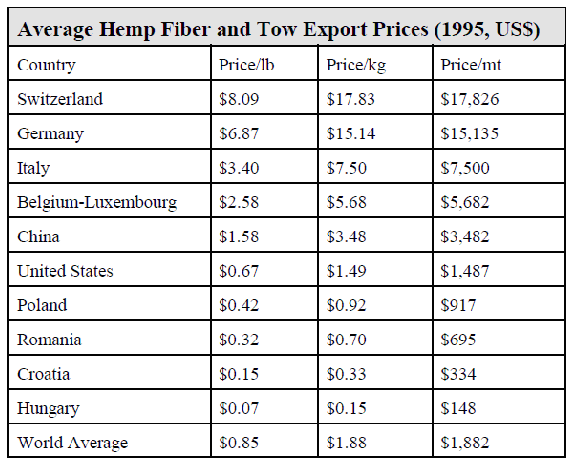
Average hemp Fiber and Tow Export Prices (1995 US$)
Take especial note of some of the East European producers such as Hungary (JOKE; at 7 cents a pound, no wonder they call the place HUNGRY). Thus the implication being that America would have a hard time completing against foreign farmers. And the truth be told there’s no way our farmers can indeed complete on price with (again let us say) farmers in Hungary. At least not at the prices shown on the table above. And she is not alone, the Internet if full of such reports claiming (in-effect) that, even if legal, low cost third world producers will swamp American farmers out of business.
However, even David Marcus’s figures are somewhat revealing in what they say/don’t say.
Noting that:
- The average world price for Hemp Tow and fiber was given as 85 cents a pound
- That WW-2 farmers were growing 2.7 tons of hemp stalks per acre
- That there are 2,000 pounds per acre
- That only between 20% to 30% of a Hemp stalks weigh/volume consists of fibers (note we use 25% in order to keep the math simple.
[ (0.85 cents) x (2.7-tons) x (2,000) x 25% = $1,148 per acre per year ]
Not bad in 1995 dollars AND this amount does not include what the farmer will also be making from the Hurd’s portion of the stalk nor seed.
However, this should not diminish the treat our farmers face from low cost foreign producers. A factor which, as can be seen the following quotes (both coming from the WW-2, Hemp For Victory campaign), show, has been talked about for some time now.
“It’s a race for supremacy between the Negro slave labor under the lash of Japanese rule in the East Indies and our own hardy and capable Midwest farmers” * -- Wisconsin Agriculturist & Farmer; Mar. 6, 1943* Our apologies if anyone is insulted by the racial slurs, that was just the way they talked back then.
“It is reasonable to believe that the Japanese will follow the scorched earth policy in evacuating conquered territories, he continued, so that it will take from three to five years after the war before the hemp industry could be re-established in the Philippines and Java. Before that time American ingenuity will have established the hemp industry firmly in this country, he believes.
Many of the problems in connection with the growing of hemp in this country, such as the high labor cost, already are being solved, he pointed out. Turning of retted hemp by hand, principal objection raised by farmers asked to grow vital war crop, already has been eliminated, he believes, machines have been developed separately in Iowa. Illinois and Wisconsin which will do the job, “ -- MasonCityGlobeGazette1943-05-05p15 - “Clams Hemp to Be Permanent Post-War Crop”
So the problem being addresses is nothing new, if fact it was the reason why America lost its dominance in Hemp growth in the first place. Hemp was a very Labor intensive industry, American labor was very expense and so we couldn’t complete with the much cheaper foreign imports, especially after the annexation of the Philippines. A situation that for good or for bad, now allowed tariff free imports from Filipino plantations (using Filipino workers if you get the drift), to flood our markets with cheap hemp and cordage products.
However, due to our friends in Japan, those imports stopped during the Second World War and we were thus forced to grow our own again. After the war however, our other much thought of friends (the narcotics police) once more proclaimed Industrial Hemp the same as Marihuana and crushed the industry yet once again. Thus it was (literally in our case) the enemy within that brought down our post war Hemp Industries, NOT Third World Farmers.
But that is neither here nor there, what is important is that Ms. Vantreese’s report (and just about all others) reached their conclusions which may/may not have been valid at the time, without taking several vital, very modern-day factors into account.
- First, many third world nations simply are no longer going to sell on the cheap anymore. Farm products are simply too valuable and everyone knows it. For example, the worst case offender on the table above “Hungary” is now part of the European Union and thus able to command much better prices. The same is true of other former Iron Curtain nations found on the table.
- Next, there is a feeling among third world nations that they can create more local jobs and earn more money, if they sell their products with as much value added as possible. Thus instead of willingly exporting raw cordage fibers, they instead wish to also do their own stalk milling, transform the raw fibers into cloth, and if possible manufacture the actual clothes themselves. It makes more money for them, keeps their workers happy, but also creates problems for countries that DON’T produce their own Home Grown.
- Then there is the problem of what is now being termed, “Food Insecurity.” Simply put, we are staring the Malthusian Prophecy right in the face. You might recall, he was one of those apocalyptic types who said, that one day there would be to many people on this planet and not enough farmlands to feed them, etc. Well, we’re at this point now and for good or for bad, a lot of people now feel that those third world farmers are going to have a lot more on their minds then growing cordage materials. Yet here in Oklahoma (no insults intended) much of the growth may come from lands that can’t produce much in the way of food crops anyway.
- > Then there is one last factor that many have ignored. America’s changing viewpoint toward “Globalization.” And while this report is no place to get involved in the great debate about “Free Trade” verses “Fair Trade” verses out and out protectionism. Still it is generally recognized that many foreign countries have been taking advantage of us, and now feel that a little tip-for-tat import traffics may not be such a bad thing. --- Example: For the 2000/2001 marketing year, the European Union gave out hemp fiber subsidies of $228 per acre, so shouldn’t American have an import traffic of at least that amount? [27]
- Last of all, many ignore the fact that (given today’s technology), there are many new farm machines that greatly reduced the need for farm laborers. Thus Hemp does indeed stand a strong chance of thriving, even against what are now seen as “Low Cost producers.”
7.7 - INDUSTRIAL HEMP IN OKLAHOMA:
WEATHER & SOIL FACTORS:
As any farmer can tell you; “You don’t always reap what you saw.” Or simply put, just because one plants seed in the ground, doen’t, of-and-by-itself, guaranty a harvest.
Farmers, like many others who deal in commodities, have to worry about a variety of factors. Any of which can aversely (or favorably) effect the price of what they’re growing as well as their very crop itself. And like any commodity, hemp also will respond to market, as well as natural forces, way beyond the control. However, with that said, Oklahoma (as can be seen below) seems to fair very well, and in fact is in a very favorable situation due to its claimant and weather conditions as oppose to say a farmer in snowy Wisconsin.
- SOIL CONDITIONS:
- Hemp will grow just about anywhere, but is somewhat averse to acidic or sandy soils; neither of which are a major problem here in the state.
-- http://www.ogs.ou.edu/pubsscanned/EP9p16_19soil_veg_cl.pdf -- Contains a pretty good map of soil condition. Yes, we do have some areas with sandy/acidic soil conditions but in general Oklahoma is blessed with almost perfect soil conditions. - WATER USAGE:
- Making references to the water map below: While needing moist soil (for best growth), Hemp doesn’t require nearly as much water use as many other crops presently being grown in the state. And while true, Oklahoma in the past has experience some prolong drought conditions, still in general, given our number of rivers, lakes, etc., and average weather patterns, water should not be a major concern. Simply put, if your irrigating your fields now, or providing water to your livestock, you shouldn’t have any trouble with Hemp growth. In fact, as Hemp requires way less water then (let us say) cotton, it will actually turn into a plus for the state.
- INSECT PESTS:
- The Hemp plant, while not totally immune to insects, Hemp does have the advantage of (in baby language) not tasting so good to insects. Thus giving it a sort of insect immunity not found in other crops, which in turn means that farmers do not require as much insecticides, which in turn saves them money, . . . etc. However, it should be stressed that sooner or later (Mother Nature has a way of doing this to us), some supper-duper insect will come along and cause trouble. However the same can be said for just about all other crops out there.
- WEATHER CONDITIONS:
- Weather wise, Oklahoma probably sits on top of the best Hemp growing weather possible, with (assuming mild winters), year round growth possible. And obviously, if we are hit by a giant show storm (something that occurs every now and then), damage to the crop may result. However, as Hemp has the ability to withstand mild frosts, we should be able to do all-right.
- GEOGRAPHICAL LOCATION:
- Oklahoma sits in one of the best geographical location imaginable. While Hemp seeds do not require much in the way of transport costs. Hemp fibers on the other hand (as a raw material) are somewhat bulky, and weigh a bit. So much so that in some cases it becomes economically unfeasible to ship them from (say) China all the way to North America. As an anonymous manufacturer stated, “the shipping costs will just eat you up.” Which is a big plus for Oklahoma as it is blessed with (very literally) being right in the middle of the United States, with plenty of rail and trucking facilities all about.
- SPECIAL FARM MACHINERY (Tractors, planting instruments, etc.):
- In general farm machinery for Hemp production has long ago been developed and is now presently being utilized around the world. In fact (with some minor modifications) it is possible to for farmers to utilize existing machinery for all phases of the planting and harvesting.
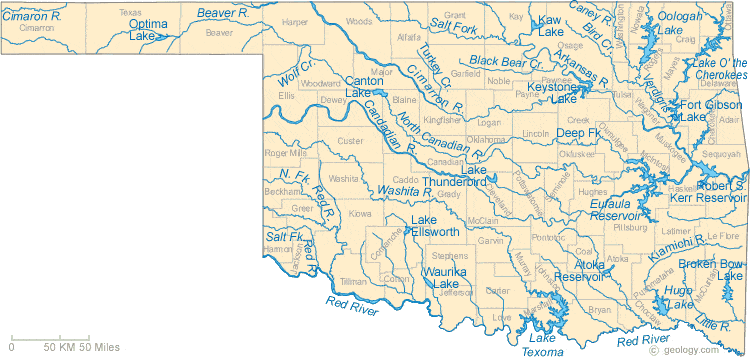
[WATER MAP OKLAHOMA]
SOIL FERTILITY ISSUES

[Two fully-grown hemp plants] [female plant left, male plant right] |
SOIL FERTILITY ISSUES: Although Hemp is an extremely ecologically friendly plant, requiring less of just about everything to grow, as opposed to just about every other crop out there. Still, as was seen from Fig-6, some fertilizer (unless crop rotation techniques are used), will probably be required. But the same can be said about practically any other crop being grown. And as Hemp requires less, this factor becomes an advantage, not a hindrance. [SEE ADDENDUM - C ] |
|---|
7.8 – INDUSTRIAL HEMP IN OKLAHOMA:
MIDSECTION SUMMARY:
Up to this point, we have solely been looking at Agricultural/Technical factors which all point to Oklahoma having a very favorable environment for Industrial Hemp Growth. Which, in simple language, means that we’re going to make a mint. For unlike the snow bound farm areas within this country, it’s possible for Oklahoma to actually grow the Industrial Hemp plant year round. Which in turn means that our farmers can obtain much more than the 2.7-ton per acre yearly yields that our WW-II (the now named Hemp For Victory era) farmers were growing.
However, there are other factors, OTHER THAN just agricultural issues involved. There are those who claim that ALL this talk about Industrial Hemp becoming a billion dollar a year Industry here in Oklahoma as being nothing more than a fantasy. One such individual Chris A . . . . simply states that
"Hemp has always been promoted as the next big crop, but it never really took off," he said. "It was never more than a niche crop that farmers used for fiber."To which we can only roll-our-eyes and say, Chris baby, I’m going to put it to you this way:
There’s a reason why Colonial era laws made it MANDATORY to grow Hemp.
There’s a reason why Slavery and the Hemp industry in Kentucky, were so closely linked. [28]
There’s a reason why Imports started to replace our own Home Grown Hemp industry AFTER the civil war.
And that reason is real simple to understand; Hemp was such a backbreaking very labor-intensive industry that American farmers simply didn’t want to grow it. The story was the same here in Oklahoma free-willing labor was just too rare and costs too much.
Then something wonderful happened around the turn of the 19th into the 20th century. Someone invented the tractor.
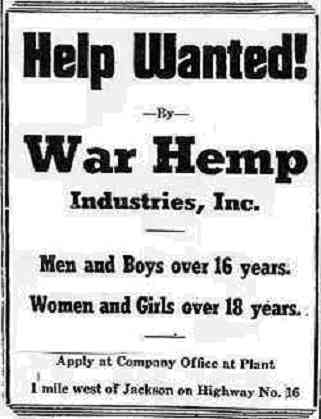
|
Which was a good thing, for these new machines came just in time to help us out during the Second World War. Note that even kids as young as 16 were being asked to report for work. – Meaning, while there was labor there to perform, the backbreaking part had by this point been taken out of the equation. In addition, the labor needed for plowing and harvesting had by this time also been greatly reduced. Thus, the logic behind Chris’s arguments (while historically correct) is now technically flawed. But that is nether here nor there, so far what has been brought out is that from a technical standpoint, Industrial Hemp will not only grow here in Oklahoma, it will do so be doing so under almost ideal conditions. |
|---|
7.9 - INDUSTRIAL HEMP IN OKLAHOMA:
ATTACHING A FINANCIAL FIGURE per acre :
How much $$$ can a farmer “realistically” expect to receive per acre/yr of Hemp growth?
Quoting an expression from the 1950’s; “that’s the forty-thousand-dollar question?” Especially as so many out there (farmers, dealers, manufacturers, governmental blocks) are going way out of their way to keep it a secrete. Even the Europeans who originally were very open about their data are becoming more and more tight-lipped of late, and not without good reason. Why tell a buyer that the last guy just before him bought at two-dollars a pound, when there’s a good chance that his going to offer of three? Knowing the laws of supply and demand, why not keep quite about an extraordinary large hemp crop for the year?
Thus it appears that it’s in a lot of peoples economic interest to keep quite about exact growth and pricing data. A situation which helps them, but also means that all buyers/sellers enter into agreements blindly, not knowing what the person next to them is doing. Simply put, there’s no way of looking up today’s price of hemp on the Chicago commodities exchange, because no one is telling.
A situation that makes it all but impossible to come up with any meaningful figures (via normal means), forcing us to use runaround procedures in order to obtain any kind of useful figures.
7.9.1 - THE OPTIMIST'S VIEWPOINT:
The optimist’s viewpoint (those who see thing rose colored glasses), can best be summed up as follows:
“As a child of the 1980s, Loflin was left with a bitter farming taste from a dire decade of agricultural economics. He left farming for construction, but began researching hemp after reading about big returns gained by producers in Canada. “We made $40 per acre off wheat, but I saw Canadian farmers pulling in $300 per acre from hemp, and it blew me away,” he explains. “I studied it and learned all I could.” . . . “Farmers are very curious and want to know the returns from hemp. There’s good money in seed and you can pull $300 per acre right now at a minimum, but the potential is there for $1,800 per acre and even higher,” Loflin (a Colorado Farmer who grows hemp) says.” ---“Colorado Farmer Shatters Hemp's Fiber Ceiling” [29]A figure that, at least by one European report, may actually be a bit on the low side: [30]
“The study of hemp market prices in 2012-2013 shows that the price of technical hemp fibres is approximately 600-800 EUR/t (Euro dollar per Ton), whereas the price of technical fibre of hemp used for paper production is 350-400 EUR/t, but the price of hemp sheaves – 200 EUR/t (stable price with upward trend), and the price of hemp seed is approximately 1200 EUR/t (in 2002, the price was 250 EUR/t, but in 2012 – already 1000 EUR/t).”Meaning that in 2013 European Hemp farmers were receiving the following:
- Price for (the long) high quality fiber is set at around $600 to $800 euro dollars per ton.
- Price for (short) low quality fiber is set at around $350 to $400 euro dollars per ton.
- Price for Hurd is set at around $200 euro dollars per ton.
- Price for Hemp Seed is set at around $1,200 euro dollars per ton.
- Price for (the long) high quality fiber = $700 euro dollars per ton.
- Price for (short) low quality fiber = $375 euro dollars per ton.
- Price for Hurd = $200 euro dollars per ton.
- Price for Hemp Seed = $1,200 euro dollars per ton.
| WARNING: As a European report, it’s assumed that they are making reference to the “metric-ton,” which equates roughly as 2,204.6 lbs (approximately 10% more), then the American ton is only 2,000 pounds. |
The following figures constitute the best figures (from a 2013 European Union report) that we’ve been able to locate, and will a bit old but can still be useful in obtaining ballpark figures. --- Note that ALL calculations below will assume: 2.7-tons-per-acre/per year; --- that being the same as America’s WW-2 (Hemp for Victory) farm statistics. However, as the Europeans are (probably) making reference to the metric-ton, we have to do a bit of conversion.
[ (2.7 American tons) x (0.907 conversion number) = 2.45 Metric tons
------ THE MATH:
[NOTE --- if the reader doesn’t want to go through this, s/he can just jump down of this section and obtain the finalized answer.
Only between 20% to 30% (to keep the math easy we universally use 25%), of the Hemp stalk (by weight/volume) contains the Fiber Material in question and that in turn (for pricing purposes) has being divided into two parts:
75% consisting of long fibers (commanding the 600-800 euros per ton)
25% consisting of short fibers (commanding the 350-400 euros per ton)
Which allows us to calculate the following per acre:
[(2.45 tons) x (25%) = 0.613 tons] of (both short/long) fiber.
Which in turn means:
[(0.613 tons of total fiber) x (75%) = 0.4594 tons of long fiber]
and
[(0.613 tons of total fiber) x (25%) = 0.1534 tons of short fiber]
Which in turn translates into:
(0.4594 tons of long fiber) x ($700 euro dollars) = $322 euro dollars
and
(0.1534 tons of short fiber) x ($375 euro dollars) = $57 euro dollars
Which added together makes:
($322 euro dollars) + ($57 euro dollars) = $379 euro dollars per acre per yr.
So just from the fibers part of the hemp stalk alone, the farmer is likely to obtain $379 euro dollars, and that’s per acre. NOW we must also add in (calculate) for the Hurd portion of the stalk as it also has financial value. . (Used today, mostly to make particleboard, building materials, and paper products). It accounts for no less than 55% of the enter Hemp stalk
[ (2.45 tons per acre) x (55%) = 1.348 tons of hurd per acre ]
Which gives us:
[(1.348 tons of hurd) x ($200 euro dollars) = $270 euro dollars]
Which in turn adds up to the total final:
[($379 euro dollars) + (270 euro dollars) = $649 euro dollars per acre/yr ]
EURO TO DOLLAR CONVERSION:
At the 2013 exchange rate of 1euro = $1.35, that gives us $876 US dollars per acre. Which more or less fits in with the above statements issued out by the optimist. After growth expenses, the farmers are still going to rack up quite a nice nest egg, way beyond what they can make growing other crops. And while yes, there are some WARNINGS:
- The above figures were ALL calculated using 2013 figures. The price of the Euro has dropped quite a bit since than against the dollar.
- The European Union gives out Farm Subsidies for agricultural production (including Hemp farming). But then we do the same for our farmers over here.
- No mention of Hemp Seed growth was made in the above example. However, it is our understanding that the profits (per acre per year) would have been much higher as Hemp Seed is at the present time commanding a premium WAY NORTH of Hemp stalks grown primarily for fiber.
- First, the above calculations were done using a figure of 2.7 tons (per acre/per year), which comes from old 1944 (Second World War) Hemp-For-Victory era statistics from the state of Illinois. A snow bound state with maybe two good crop seasons per year. Here in Oklahoma due to Oklahoma’s more favorable weather, it’s possible to have more plantings.
- Next, we were using “Low Ball” percentage figures to calculate earnings from Hemp Hurd as well as fibers. To obtain more probable economic figures, one would need to add at least an additional 5 to 15 percent more to the above calculations.
- The above calculations totally ignores any kind of Hemp seed harvest. A factor which of and by itself could prove much more profitable then Hemp’s growth solely for its stacks.
- Then it must be noted that yesterdays “Hemp for Victory” farmers were for the most part, not very well experienced with Hemp growth. Any farmer can tell you that it takes a while to get the hang of the thing. The same goes for the equipment which those farmers were using. With today’s equipment, it might be possible to drastically increase the tonnage per acre produced.
- Last of all, (some are saying that) with today’s modern farming techniques, it is now possible to grow as much as 5-tons of Hemp stalk per acre (per year), but 3.5 to 4 tons sounds more realistic.
7.9.1
SUMMARY/COMMENTS:
According to the optimistic viewpoint, farmers will rack in well over $876 (in 2013 US dollars) per acre. A figure that seems to be supported by the latest (meaning 2013) open statistics available. And due to the various reasons already stated, the figure calculated should be seen as extremely “Low-Ball” starting figures.
7.9.2 - THE PESSIMISTIC VIEWPOINT:
AN EDITORIAL COMMENT AND A WARNING:
When this report was first being put together, there was ever the intention of being fair-minded. No matter how pro-Industrial Hemp the compilers of this report were, it is important not to look at things through the rose colored glasses of wishful thinking. . But, instead to hear both sides of the issue and report their opinions as openly and objectively as possible. We would have been doing everyone a disservice had we not done so. Thus, our original intention was to simply compile a listing of the “pessimistic” viewpoints or concerns and presenting them in a reasonable and fair manner. To use their own math and work out (as closely as possible) their financial findings, the idea was to be fair to all viewpoints.
However as more and more information on their viewpoints was gathered, it became obvious that something was terribly wrong. Why were so many uses of deceitful statistics? Why so many uses of mathematical slight-of-hand? Why were so many obvious (to an informed reader) farming factors being left out? At first, the situation was a bit confusing, then it became obvious what was going on.
Here we wanted to remain politically neutral and thus did not feel it appropriate to continue with the immediate subject matter as part of this report.
Here, all that we can or should say, is that yes, the pessimistic viewpoint is out there. And that yes, they too have written up financial reports of their own on the subject with their own math. However, we (being very fair and impartial) were not able to confirm their figures or math. And maybe that’s enough said on the subject.
SECTION 7 - SUMMARY:
Obviously (see sec 6.9.2), this report has been forced to deviate widely from its originally intended purpose. That being to obtain actual real world financial numbers that we could use to determine what financial impact re-legalization would have on our states general revenues. And as re-legalization would open the way for Industrial Hemp growth in Oklahoma, to examine/determine just how much in new state revenues it would create. However, as with any commodity, especially one for which due to a myriad of issues, we have not been able to obtain any recent/specific data for.
But be that as it may, and “necessity being the mother of invention”, we originally thought to obtain at least a ball-park figure by obtaining a Maximum figure (sec 6.9.1) and then a minimum figure (sec 6.9.2), which would at least give us a couple of starting points. Then “hopefully” with some deviation-al math, allow us to come up with a realistic in-between figure we could plug in and thus obtain a ballpark figure.
While the Maximum figures, hinted at by the supporters of re-legalization made some sense, and were at least supported by actual financial facts. The Minimum figures were put together . . . (maybe it’s best not to go into that area, if the reader is interested, s/he can look over Addendum-C). For our part here, let’s just say that no independent accountant type would except them.
Thus this report was force to center itself around the optimistic side of the boundary, specifically making use of the established European figures previously established and assuming a crop being grown for fiber stalk as oppose to seed:
-
Using today’s rate of exchange:
[($649 euro dollars per acre/yr) x (1.15) = $746 US dollars]
Now adjusting for inflation (2013 - till- 2017) give us:
[($746 x 1.05 = $783 2017 dollars]
HOWEVER, THIS IS JUST ONE methodology of calculating a given figure:
- If we were to have used the 2013 rate of euro to dollar conversation (sec, 6.9.1): (which at the time was $1.35 per US dollar would raise the figure to, $876 US dollars per acre. Which adjusted for inflation would in today’s dollars be (1.05 x $876 = $920 US dollars per acre)
- Or if we were to have used the world average hemp Fiber and Tow Export Prices (1995) price of 0.85 cents/lb. Would mean (as shown in sec. 6.6):
[ (0.85 cents) x (2.7-tons) x (2,000) x (25%) = $1,148 per acre per year ]
Which adjusted for inflation [ ($1,148) x (1.61) = $1,848 per acre per year ] - Or we could have made use of figures given to us by Colorado farmers who are actually/presently growing Industrial Hemp and who claim that tbd figures.
Thus for the rest of this report, we will simply make use of the Ball-Park figure (wart’s and all) $783 dollars per acre/yr.
7.10 - INDUSTRIAL HEMP IN OKLAHOMA:
NUMBERS OF ACRES:
Now that we’ve obtain at least a “Ball-Park” figure of $783 per acre/yr. We now need to know just how many acres of Oklahoma agricultural land is going to be involved in Hemp Production? And to even take a guess-timent first requires us to look at three different kinds of very different acreage.
7.10.1 - ESTABLISH AGRICULTURAL FARMLANDS:
According to state statistics [32] Oklahoma has some 68,595 square miles of actual dry land, (as oppose to land underneath a lake or river, etc). Of which 34,2000,000 acres consists of established agricultural lands. However, it appears that only about a third of that is actually established crop lands (the other two-thirds being ranch lands), and that one third also includes fruit orchards, etc., or things not normally associated with actual crop growth such as wheat, or rye, etc.
The table below also comes from the same report:
| CROP | ACREAGE | Acreage X $783 |
| Winter Wheat | 5,300,000 | $ 4,149,900,000.00 |
| Oats | 40,000 | $ 31,320,000.00 |
| Rye | 240,000 | $187,920,000.00 |
| Canola | 140,000 | $ 109,620,000.00 |
| Corn Grain | 310,000 | $ 242,730,000.00 |
| Corn, silage | 15,000 | $ 11,745,000.00 |
| Sorghum, Grain | 440,000 | $ 344,520,000.00 |
| Sorghum, Silage | 15,000 | $ 11,745,000.00 |
| Soybeans | 395,000 | $ 309,285,000.00 |
| Peanut | 10,000 | $ 7,830,000.00 |
| Cotton | 215,000 | $ 168,345,000.00 |
| Sunflowers | 5,700 | $ 4,463,100.00 |
| All Hay | 3,020,000 | $ 2,364,660,000.00 |
| TOTAL ABOVE | 10,145,700 | $ 7,944,083,100.00 |
[Table also allows for double acreage counts, - cases where wheat is planted one season, rye the next, etc.]
Which if one were to add up all the above-mentioned crops, accounts for a total crop growing acreage of 10,145,700 acres. A figure, while not totally accurate, does allow us to play some games with the math. What if ALL of Oklahoma’s farmers were to switch (overnight) to Industrial Hemp growth? If so and if we assume the $783 figure calculated above, gives as:
[(10,145,700 acres) x ($783) = $8-Billion dollars]
And (carrying on with our fantasy), if ALL farmers (remembering that crop growth is already a $2-Billion dollar a year industry), were to pay just 5% state taxes on their profits of $6-Billon, would mean an extra $300-Million in additional state revenues.
A nice figure, but let’s be blunt, FAT-CHANCE of ALL crop growers switching over to Industrial Hemp overnight. However, it might be more practical to think of just those farmers that are now growing Winter Wheat, that figure comes out to:
[(5,300,000 acres) x ($783) = $4.1 Billion dollars]
The game can be played (mixing and matching until the cows come home. But at the end of the day, the math is simple:
Presently ALL our Oklahoma croplands (all of them put together) account for no more than $2-Billion dollars in agricultural sales.Thus any figure that increases that amount automatically causes an increase in earned tax revenues, which in turn leads to more tax monies for our state coffers --- WITHOUT AN INCREASE IN TAXES. And Industrial Hemp (sec. 6.9) will increase that amount by a lot . . . quite a pretty penny.
7.10.2 - RANCH LAND CONVERSIONS:
At present Oklahoma has two acres of agricultural land devoted to ranching for every one acre of cropland. This is due to a number of (we presume) mostly economical factors. Sometimes, maybe, ranching just brings in more money (acre per acre) than crop growth. But it is safe to presume that one of the main reasons for this being is that some acreage, while ok for growing grasses and weeds (no pun intended) simply ain’t good enough for actual crop production. Here are also talking about lands that are running up the side of hills, or isolated patches where it just isn’t practical to bring in a tractor, etc. BUT, what if a crop like Industrial Hemp, which is not a high maintenance plant, were allowed.
If grown for seed, all that is really required is for someone to simply plant the seed (which can be done with a lawn mover size device), and come back some 3-4 mounts later with some boxes to load the seeds into. That’s it. Hemp needs little if any pesticides and of-and-by itself is a herbicide. Simply put, it’s the perfect low-maintenance crop that ranchers have been looking for, for a long time.
HOWEVER: As previously noted, while Hemp is one of the most eco-friendly plants out there, it does require either some fertilizer, or to be planted as part of a crop rotation. Or as will more likely be the case, ranchlands used for such purposes will in all likelihood have only one planting per year. That will give the soil the opportunity to replenish itself
Thus for our purposes here, we will not only not know exactly how many new acres of former ranch lands will be switch over to Hemp production, but also have no way of knowing exactly what sort of harvest we can expect per acre.
7.10.3 - ESTABLISH BUT FALLOW FARMLANDS:
These constitute those Farmlands that, while on paper are “technically” classified as agricultural are in effect laying fallow with no present agricultural uses. Croplands that at the present moment are considered “Too Marginal” or “Too Small” for actual crop growth.
However, if a new crop, one that economically made sense were to come along, then it’s easy to imagine these now fallow farmlands could once again come to life. Re-using a previous example:
There’s a woman who the author is familiar with, who lives on about 12 acres of potential cropland. However at present, she explains that with only 12 acres, it’s simply not economically practical to plant anything more than a victory garden there. However, if Hemp was re-legalized, it then becomes very practical for her to borrow a seed sower. Wait about 4 months (Hemp requires little maintenance) then harvest and box the seed crop for sale. Her earnings (even without a lot of equipment will be well into the thousands) thus making it well worth her time. ---- Now, multiply the thousands of acres that are at present just sitting around out there doing nothing, and one can see the vast potential of new wealth coming into the state.And here it should be noted that this “too small to plant anything factor,” is quite a common occurrence here in this state, where (what used to be) large farms have been so subdivided. That the farms (if they can still be call that) at the present time appear more like postage stamps then actual farms.
Then there is the too Marginal factor that cannot be ignored. Some state lands, simply are that, too marginal to practically be put into full time crop production. However, Hemp being a pretty hardy/low maintenance crop might (at least for one planting season per year) be grown on such lands.
Our problem here however is that there is no actual way of determining exactly how many of these acres are going to come on line once re-legalization is established. In addition, there is no way of knowing exactly how productive, nor how many planting seasons per year they will have. However, some simple math indicates the shear financial numbers that we are talking about. If just one square mile per county is now put into Hemp product; Just one square mile per county.
Oklahoma has a total of 76 counties, and as there are 640 acres per square-mile, therefore:
[$887 x 76 x 640 = $43,143,680-Million dollars]
And assuming a tax rate of just 5%, that would equate to $2.2-Million dollars in additional tax revenues. But again, we don’t know how much fallow land will be put into production. A factor that explains why we must add a (PLUS) at the end of any actual figures calculated.
In addition it should be kept in mind, that in some cases we are talking about the sides of hilltops, etc., thus thickly grown hemp plantings are not very practical. On such soils, it will probably be more economical to grow hemp for seed value, which by definition requires a more thinly (less plants per area of land) planting. But also makes it easier for the landowner to harvest the seed, which also brings in a pretty good price.
But once more, the exact numbers, both of acres and actual production tonnage per acre will not be known until well after re-legalization.
7.10. 4 – AGRICULTURAL PROFITS AND NEW TAX REVENUES:
Were it not for present day legal issues involved, this would be an easy figure to calculate. Simply put, we would have determined the number of acreage involved, tabulate harvest numbers. Obtained an exact/about crop tonnage number and after looking up the current commodities price of Hemp, calculated a figure.
However, we don’t know and have no way of determining the exact numbers of acreage that will be put into production. Nor do we have any way of tabulating exact harvesting numbers. Thus making any actual attempt to obtain exact figures all but meaningless.
However, we were able to obtain some facts. That could point us in the right direction.
- We know that in 2013 (the latest open data available) on the subject, that European Union Hemp farmers were making more then $887 dollars per acre from their stalk productions. We do not have any data on what the Hemp seed farmers were making, but it was considerable higher. A figure that is probable on the low side as we are using a total growth tonnage of only 2.7-tons per acre.
- We know that during the Second World War inexperience farmers who had never grown the crop before were growing an average 2.7-tons per acre. We believe that in today’s world the average (assuming stalk production) will be around 3-to-5 tons per acre, and some claim more.
- We know that (weather-wise) Oklahoma has about as near prefect a climate as it comes, and thus unlike snow bound states, year round hemp crop growth is possible.
- We know that many acres of presently fallow/unused farmlands will be brought into crop production.
WANT TO KNOW MORE:
=====================
Due to space / download time considerations, only selected materials are displayed. If you would like to obtain more information, feel free to contact the museum. All our material is available (at cost) on CD-Rom format.
CONTACT PAGE
 BUDGET REPORT PRIVIOUS SECTION |
 |
 BUDGET REPORT NEXT SECTION |
 BACK TO MAIN PAGE OKLAHOMA BUDGET REPORT |